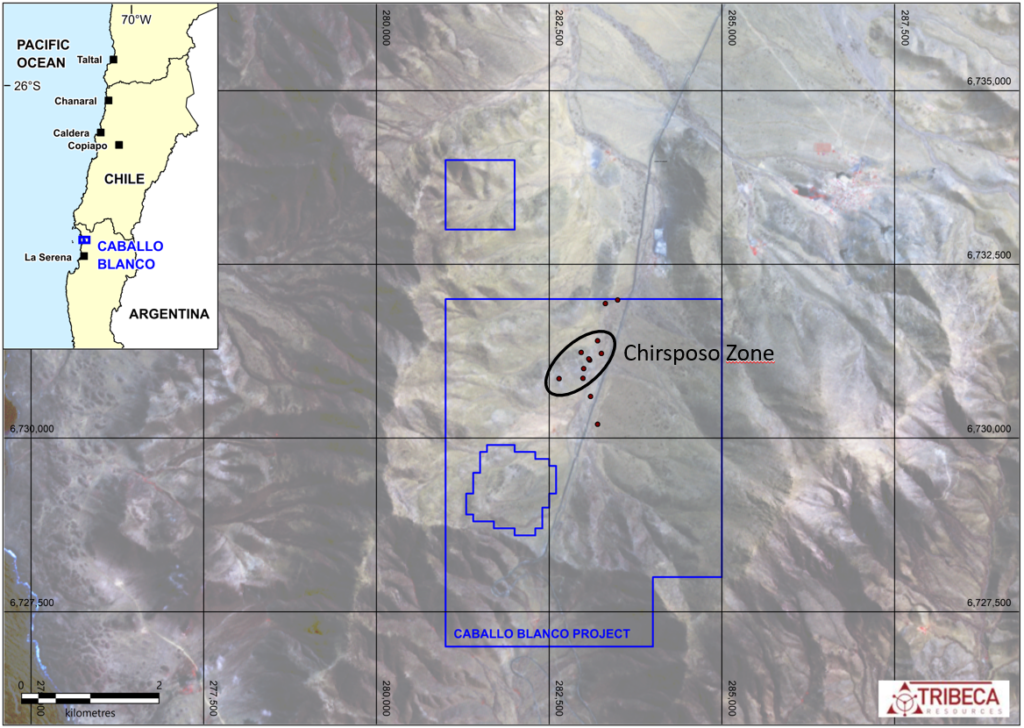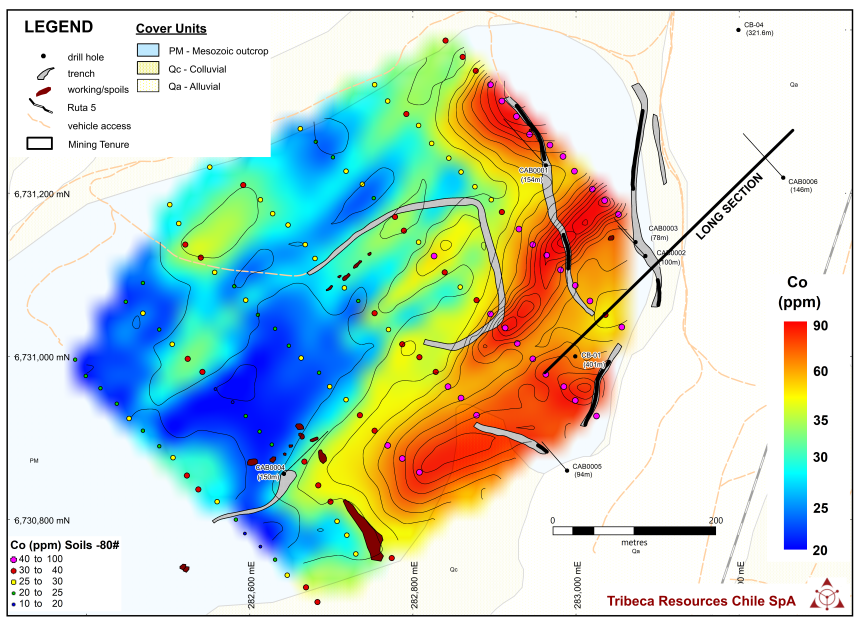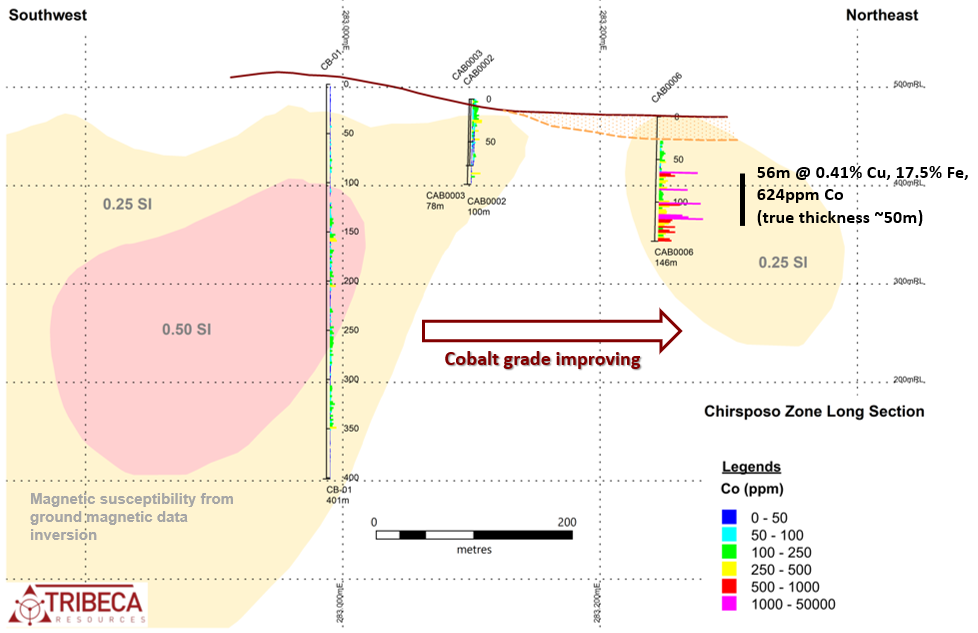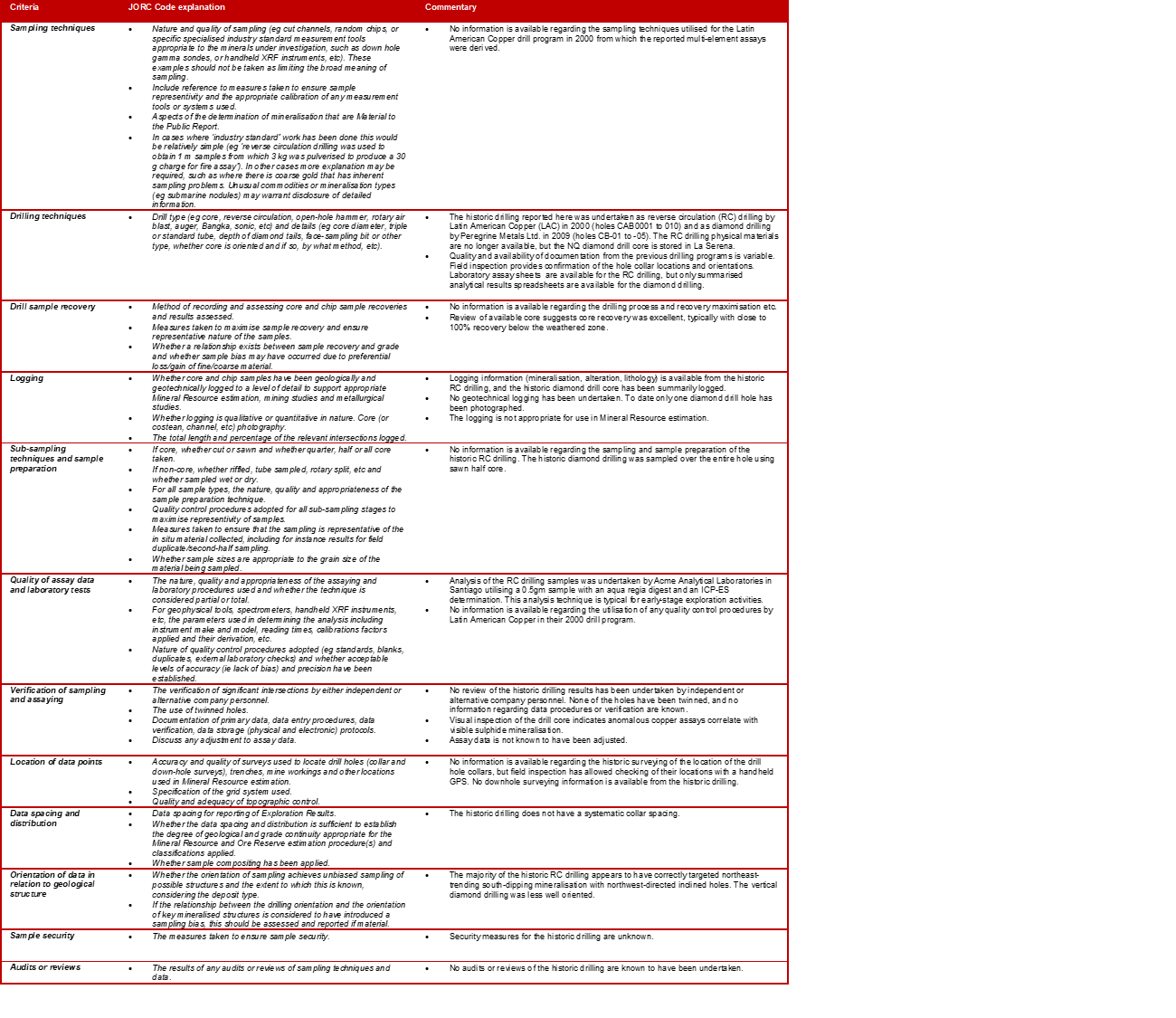Tribeca Resources receives historic cobalt assay data from the Caballo Blanco Project
Tribeca Resources Chile SpA (“Tribeca Resources”) has recently received documentation from historic multi-element assay data, including cobalt analyses, from historic reverse circulation drilling at the Chirsposo target zone within its Chilean Caballo Blanco Project. The drilling was completed by Latin American Copper in 2000, with the new data confirming and improving on cobalt assay data from a single diamond drill hole in the Chirsposo target zone completed by Peregrine Metals Ltd in 2009. Addition of cobalt assays to the previously reported copper intersections (see news release dated 15 January 2018) provides a revised table of key copper-iron-gold-cobalt intersections as provided in Table 1. The cobalt content is not ore grade, but could provide a significant by-product credit to the potential copper-gold-iron system.
The cobalt is strongly correlated with copper and iron assays and provides additional geochemical support for the interpreted zonation of the deposit to a more hematite-rich iron oxide assemblage, with better copper-iron-cobalt grades, toward the gravel covered northeast extensions of the mineralised system.
Table 1: Significant drill intersections from the Chirsposo zone drilling by Latin American Copper (2000) and Peregrine (2009).
| Hole ID | From | To | Downhole Interval (m) | Estimated True Thickness* | Copper (%) | Iron (%) | Cobalt (ppm) | Gold (g/t) |
| CAB0001 | 10 | 88 | 78 | 67 | 0.22 | 14.2 | 205 | <2 |
| CAB0002 | 0 | 58 | 58 | 50 | 0.33 | 13.5 | 130 | <2 |
| incl. | 0 | 38 | 38 | 33 | 0.42 | 13.1 | 143 | <2 |
| CAB0005 | 12 | 74 | 62 | 53 | 0.25 | 11.1 | 180 | <2 |
| CAB0006 | 64 | 146 | 82 | 71 | 0.35 | 19.2 | 576 | <2 |
| incl. | 64 | 70 | 6 | 5 | 0.85 | 18.4 | 978 | <2 |
| and | 98 | 120 | 22 | 19 | 0.50 | 22.7 | 950 | <2 |
| CB-01 | 122 | 176 | 54 | 27 | 0.38 | 14.8 | 88 | 0.09 |
| incl. | 150 | 160 | 10 | 5 | 0.97 | 24.4 | 212 | 0.20 |
| CB-01 | 226 | 268 | 42 | 21 | 0.22 | 15.7 | 99 | 0.07 |
* The intersection angle of the drill holes and the mineralised bodies is currently poorly constrained but estimated at approximately 60° for the CAB holes and 30° for the vertical hole CB-01. The lower detection limit for gold in the assaying of the 2000 LAC RC drilling (CAB0002 and CAB0006) was 2ppm.
CHIRSPOSO ZONE
The Caballo Blanco project is located within the Chilean Coastal IOCG Belt and represents a mid-stage copper-iron-gold-cobalt exploration project, with significant drill intersections to date. The Chirsposo zone comprises a set of northeast-trending historic copper and iron workings in the northern Caballo Blanco project area (Figure 1). The zone is hosted within Upper Jurassic – Lower Cretaceous diorites and andesites, which display variably developed sodic-calcic alteration and overprinting magnetite-pyrite-epidote-quartz±chalcopyrite alteration.
The Chirsposo zone was the object of trenching and drilling by Latin American Copper (LAC) and Peregrine in 2000 and 2009. The drill programs produced significant intersections of thick low-grade copper mineralisation, with accompanying iron±cobalt±gold. Tribeca Resources has recently acquired copies of the original hardcopy laboratory assay sheets and compiled the multi-element data.

Figure 1: Location of the Chirsposo target areas within the Caballo Blanco project. Dark filled circles represent the previous drill holes.
COBALT IN SOIL ANOMALISM
The presence of elevated cobalt assays from the drilling, broadly coincident with the iron and copper mineralisation, is consistent with the strong cobalt anomalism evident in surface geochemical data (soil analyses) collected in 2017 (see Tribeca news release dated 15 January 2018) which returned a maximum cobalt in soil value of 97 ppm cobalt. The cobalt in soil anomalism strongly correlates with anomalous Cu, Fe, Mo, Ni, P, and V. No gold analysis was undertaken on the soil samples.
The cobalt in soil anomalism forms three well defined approximately northeast-trending +60ppm Co zones (Figure 2) within three broader +500ppm copper in soil anomalies (see details in 15 January 2018 news release). Surface mapping and drilling suggests that these copper-cobalt anomalous zones correlate with northeast-trending mineralised shears.

Figure 2: Plot of soil cobalt results from the Chirsposo Zone -80# sampling (aqua regia digest with ICP-AES analysis). The cobalt anomalism at the eastern end of the survey grid disappears under alluvial cover to the northeast. The strongly northeast-trending cobalt anomalism is consistent with the surface geology indicating an approximate northeast (050°) orientation to the mineralised shear zones. The cobalt in soil contour lines are 5 ppm intervals. The location of the long section from Figure 3 is shown on the diagram.
COBALT REVERSE CIRCULATION DRILL ASSAYS
Review of the drill data indicates the cobalt mineralisation is improving along strike to the northeast (Figure 3), in line with improved copper and iron grades. Review of the ground magnetic data inversion suggests the improving grades correlate with a zonation of iron oxide from magnetite to hematite. The best copper-iron-cobalt intersection, comprising 82m @ 0.35% Cu, 19.2% Fe, 576ppm Co from 64m in CAB0006, is located under thin (25m) gravel cover off the northeast end of the outcropping mineralised alteration system (Figure 2 and Figure 3). Unfortunately, the RC sample material from the 2000 drilling is no longer available so the mineralogy and mode of occurrence of the cobalt is unknown.
This additional cobalt drill data adds to the prioritization as a drill target of the shallow gravel covered areas that remain open to the northeast of the mineralisation known from drilling to date.

Figure 3: Long section from the Chirsposo target zone, highlighting the strong increase in cobalt mineralisation towards the northeast, where hole CAB0006 tested below the thin (25m) gravel cover. The increase in copper-iron-cobalt grades towards the northeast correlates with an iron oxide zonation from magnetite to hematite, evident from the inversion of the ground magnetic data. The pale beige zones represent inverted magnetic susceptibilities of 0.25 SI units (approximately 5% magnetite) and the pale pink zones represent inverted magnetic susceptibilities of 0.50 SI (approximately 10% magnetite).
ABOUT TRIBECA RESOURCES
Tribeca Resources is a private Chilean exploration and development company. The team behind the company came out of Glencore’s copper business and established Tribeca Resources with the objective of building a portfolio of copper dominant properties in the Chilean Coastal IOCG Belt that can be advanced towards code compliant resources.
The Caballo Blanco project is 100% owned by the private Chilean company Bluerock Resources SpA (“Bluerock”) in which Tribeca Resources holds a 62.5% equity interest. Tribeca Resources is partnering with the current owners who retain a significant minority equity interest and have on-going technical, strategic and administrative involvement.
For further information:
Paul Gow – Executive Director Thomas Schmidt – Executive Director
paul.gow@tribecaresources.com thomas.schmidt@tribecaresources.com
+61 497 572 956 +44 77 7577 1217
COMPETENT PERSONS STATEMENT
The information in this release has been reviewed by Dr. Paul Gow, Executive Director of Tribeca Resources Chile. Dr. Gow is a Member of the Australasian Institute of Mining and Metallurgy (AusIMM) and the Australian Institute of Geoscientists (AIG), and has sufficient experience which is relevant to the style of mineralisation and type of deposit under consideration and to the activity which he is undertaking to qualify as a Competent Person under the 2012 Edition of the Australasian Code for reporting of Exploration Results, Mineral Resources and Ore Reserves.
APPENDIX 1
JORC Code, 2012 Edition – Table 1
Section 1 Sampling Techniques and Data
Section 2 Reporting of Exploration Results

1305 - 1090 West Georgia Street
Vancouver, BC V6E 3V7 Canada